Exploiting the animals we love to hate
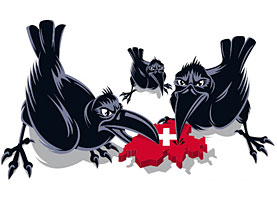
The rightwing Swiss People's Party has ruffled a lot of feathers with its campaign against allowing Bulgarians and Romanians to work freely in Switzerland.
Its poster shows three huge black birds with curved beaks and a cruel glint in their eyes pecking away aggressively at a small Swiss map.
“The ravens are aggressive, cunning and devious,” according to Pirmin Schwander, head of the People’s Party campaign committee when he presented the campaign to the media.
Not a bit of it, if the bird protection society BirdLife Switzerland is to be believed. “Ravens are certainly not plunderers,” François Turrian, head of the association for western Switzerland told Swiss television. “They make the most of food people leave out for them, or which they find for themselves.”
They are highly intelligent and faithful to the same mate throughout their lives – and stay more or less in the same place.
Attention grabbing
It’s not the first time the People’s Party has used animals in attention-grabbing campaigns. In 2007 its “black sheep” poster showing three white sheep kicking a black sheep out of Switzerland spawned international controversy – and was both copied and parodied widely.
In 2004 it used three sharp-toothed red rats gnawing at a purse to attack the left in a referendum about raising VAT.
Why are these posters so effective? It’s partly the eye-catching design – the animals are huge and centrally placed, Philippe Meyer, Managing Director of the Saatchi & Saatchi Simko advertising agency explained to swissinfo.
But they also exploit the animals’ strong symbolic force.
“It’s much easier to express an idea through symbols using animals, than by presenting them through human beings,” he said. “People only have a few seconds to grasp what you are trying to tell them, and the use of symbols makes it easier to get the message across.”
Reputations
The use of animals in political posters is nothing new. Sometimes they feature simply as visual puns. Indeed, the famous “black sheep” poster is an allusion to the notion of the “black sheep” of the family.
Or they exploit well-known characteristics, like the lobster walking backwards used to protest against allegedly reactionary policies, or the snail failing to keep up with the times.
Not surprisingly, campaigns directly linked to animal welfare and nature protection tend to feature loveable creatures who need voters’ support.
But it would seem from the online Swiss poster collections that it tends to be aggressive animals that make most of the political running.
That doesn’t surprise Meyer. “If you think back to the stories of childhood, there were lots of aggressive animals. They polarise.”
Against such a background, the protests of BirdLife Switzerland in favour of ravens may fall on deaf ears.
“For a long time ravens were the birds of the gibbet,” Jean-Paul Haenni, curator of the Neuchâtel Natural History Museum, told swissinfo. “People think of them picking out the eyes of corpses and such like.”
Their black plumage and raucous cry have also contributed to their sinister reputation, he pointed out. They have entered the language: in German a “Rabenmutter” or “raven mother” is a woman who gets someone else to look after her child; in French a “corbeau” is a person who writes poison pen letters.
Aggression and intelligence
Other unpopular animals have had their reputations exploited in political posters too.
Several campaigns have featured rats insidiously gnawing away at something precious. More threatening still are animals with eight legs: spiders and octopuses. Spiders are like the taxman and bureaucrat, wanting to seize the hard-earned money of ordinary citizens; the octopus has been shown stretching out its tentacles to crush buildings and whole cities and regions.
These are all animals that we picture as underhand and aggressive, says Haenni. “We think of rats as swarming, and tainting our food stocks. And then, you don’t see them, but they are there.
“They come at night, they live in cellars and dirty places; all that’s true, of course, but at the same time people let their imaginations run riot about that sort of thing.”
As for octopuses “people imagine being clasped by them, and dragged into the water. Often these are simply projections of their fears.”
Like the raven, rats and octopuses are reputed among naturalists to be highly intelligent animals, but our deep seated fears are likely to go on playing into the hands of campaign managers.
Bears
An animal with a rather mixed reputation has been used in different contexts in political posters. The bear traditionally has been seen as a kind of primitive force, a bit like wild men. Bears were often venerated, says Haenni.
In Switzerland the bear is also the symbol of Bern and features in its coat of arms. Local political parties in the capital often use it in their campaigns. Under federal law, this is quite legal as long as it is clear that the party is a private organisation, not a state body. The Bernese tend to be very fond of their bears, so they doubtless do indeed have electoral appeal.
But not to everyone. Bern is the capital, and as such the source of federal laws. A big bear threatening to impose its will on the independent-minded cantons makes a perfect image.
Reputations die hard. And after all, if the message is effective, what price truth?
swissinfo, Julia Slater
The People’s Party has aroused controversy with several of its recent campaigns.
The Romanian authorities summoned the Swiss ambassador to complain about the ravens.
The black sheep campaign was denounced by the United Nations’ special rapporteur on racism, Doudou Diène
It was taken up with modifications by a number of far-right parties in other countries.
It was also widely parodied in Switzerland, often turning it against the People’s Party.
Switzerland has a rich stock of political posters thanks to its system of direct democracy.
Voters have to pronounce on matters of nationwide, cantonal or local importance up to four times a year.

In compliance with the JTI standards
More: SWI swissinfo.ch certified by the Journalism Trust Initiative
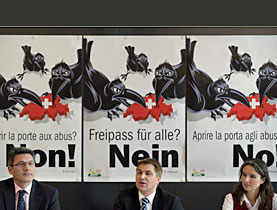
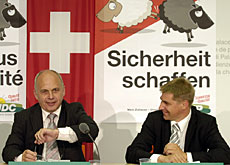
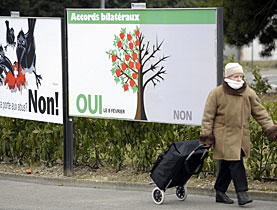
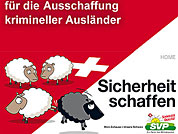
You can find an overview of ongoing debates with our journalists here. Please join us!
If you want to start a conversation about a topic raised in this article or want to report factual errors, email us at english@swissinfo.ch.